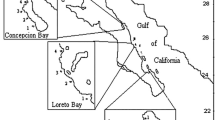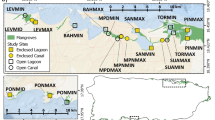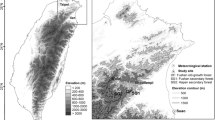Abstract
Tropical cyclones are common disturbances that have strong effects on mangrove composition and structure. Because there are numerous ecosystem services provided by mangroves, it is important to understand their adaptations and responses to these climatic events. In April 2004, Typhoon Sudal, a category 3–4 cyclone, passed over the state of Yap, Federated States of Micronesia. For four months following the typhoon we measured forest structure, above-ground biomass, tree mortality and response in six mangroves. The sites were dominated by species common in mangroves throughout the Indo-Pacific—Sonneratia alba, Brugueira gymnorrhiza, and Rhizophora apiculata. Total above-ground biomass (TAGB) of mangrove forests ranged from 211–573 Mg ha-1. Tree mortality ranged from 6% to 32% among stands. Adaptations and responses to the typhoon varied by species, as well as by geographic location. Sonneratia alba had a higher frequency of mainstems broken (26%), but was the only species that vigorously sprouted from dormant basal or epicormic tissues. Standing live trees accounted for 80–95% of TAGB, suggesting that adaptations of mangrove trees can facilitate the persistence of an intact forest structure following typhoons of this intensity. Climatic changes such as sea level rise and increased severity of cyclonic events could alter this relationship.


Similar content being viewed by others
References
Allen JA, Ewel KC, Keeland BD, Tara T, Smith TJ (2000) Downed wood in Micronesian mangrove forests. Wetlands 20:169–176
Brown JK, Roussopoulous PJ (1974) Eliminating biases in the planar intersect method for estimating volumes of small fuels. Forest Science 20:350–356
Cahoon DR, Hensel P, Rybczyk J, Mckee KL, Proffitt CE, Perez BC (2003) Mass tree mortality leads to mangrove peat collapse at Bay Islands, Honduras after hurricane Mitch. Journal of Ecology 91:1093–1105
Cole TG, Ewel KC, Devoe NN (1999) Structure of mangrove trees and forests in Micronesia. Forest Ecology and Management 17:95–109
Clough BF, Scott K (1989) Allometric relationships for estimating above-ground biomass in six mangrove species. Forest Ecology and Management 27:117–127
Davis SE, Cable JE, Childers DL, Coronado-Molina C, Day JW, Hittle CD, Madden CJ, Reyes E, Rudnick D, Sklar F (2004) Importance of storm events in controlling ecosystem structure and function in a Florida Gulf Coast estuary. Journal of Coastal Research 20:1198–1208
Doyle TW, Smith TJ, Robblee MB (1995) Wind damage effects of Hurricane Andrew on mangrove communities along the southwest coast of Florida, USA. Journal of Coastal Research 21:159–168
Fenner DP (1991) Effects of Hurricane Gilbert on coral reefs, fishes and sponges at Cozumel, Mexico. Bulletin of Marine Science 48:719–730
Franklin JF, Drake DR, Mcconkey KR, Tonga F, Smith LB (2004) The effects of Cyclone Waka on the structure of lowland tropical forest in Vav’u, Tonga. Journal of Tropical Ecology 20:1–12
Furze P, Preble A (2003) 2003 Annual tropical cyclone report. U.S. Naval Pacific Meteorology and Oceanography Center/ Joint Typhoon Warning Center, Pearl Harbor. Available online at: http://205.85.40.22/jtwc/atcr/2003atcr/
Giesen W, Wulffraat S, Zieren M, Scholten L (2006) Mangrove guidebook for Southeast Asia. FAO and Wetlands International. Dharmasarn Co., Ltd, Bangkok
Guild LS, Kauffman JB, Ellingson LJ, Cummings DL, Castro EA, Babbitt RE, Ward DE (1998) Dynamics associated with total aboveground biomass, C, nutrient pools, and biomass burning of primary forest and pasture in Rondônia, Brazil during SCAR-B. Journal of Geophysical Research—Atmospheres 103(D24):32091–32100
Hidayat S, Simpson WT (1994) Use of green moisture content and basic specific gravity to group tropical woods for kiln drying. Research Note FPL-RN-0263. U.S. Department of Agriculture, Forest Service, Forest Products Laboratory, Madison.
IPCC (2007) Summary for Policymakers. In: Solomon S, Qin D, Manning M, Chen Z, Marquis M, Avery KB, Tignor M, Miller HL (eds) Climate change 2007: the physical science basis. Contribution of Working Group I to the Fourth Assessment Report of the Intergovernmental Panel on Climate Change. Cambridge University Press, Cambridge, pp 1–18
Kauffman JB, Cummings DL, Ward DE, Babbitt R (1995) Fire in the Brazilian Amazon: 1. Biomass, nutrient pools, and losses in slashed primary forests. Oecologia 104:397–408
Kauffman JB, Cummings DL, Ward DE (1998) Fire in the Brazilian Amazon: 2. Biomass, nutrient pools and losses in cattle pastures. Oecologia 113:415–427
Kauffman JB, Hughes RF, Heider C (2009) Dynamics of C and nutrient pools associated with land conversion and abandonment in Neotropical landscapes. Ecological Applications 19:1211–1222
Komiyama A, Ong JE, Poungparn S (2008) Allometry, biomass, and productivity of mangrove forests: A review. Aquatic Botany 89:128–137
Krauss KW, Twilley RR, Smith TJ, Whelan KRT, Sullivan JK (2005) Woody debris in the mangrove forests of south Florida. Biotropica 37:9–15
Mitsch WJ, Gosselink JG (2000) Wetlands, 3rd edn. Wiley, New York
Ostertag R, Scatena FN, Silver WL (2003) Forest floor decomposition following hurricane litter inputs in several Puerto Rican forests. Ecosystems 6:261–273
Prior SA, Guard CC (2005) In the wake of a destructive typhoon: cold water, low tides, and fog. National Oceanic and Atmospheric Center (NOAA). Mariners Weather Log 49(1). 3 p Published online at: http://www.vos.noaa.gov/MWL/april_05/typhoon.shtml
Putz FE, Chan HT (1986) Tree growth, dynamics, and productivity in a mature mangrove forest in Malaysia. Forest Ecology and Management 17:211–230
Saenger P, Snedaker SC (1993) Pantropical trends in mangrove above-ground biomass and annual litterfall. Oecologia 96:293–299
Sampaio EVSB, Salcedo IH, Kauffman JB (1993) Effect of different fire intensities on coppicing of Caatinga plants in Serra Talhada, Brazil. Biotropica 25:452–461
Schneider DM (1967) Typhoons on Yap. Human Organization 16(2):10–14
Sherman RE, Fahey TJ, Martinez P (2001) Hurricane impacts on a mangrove forest in the Dominican Republic: damage patterns and early recovery. Biotropica 33:393–408
Simpson WT (1996) Method to estimate dry-kiln schedules and species groupings: tropical and temperate hardwoods. U.S. Department of Agriculture, Forest Service, Forest Products Laboratory. Research Paper FPL-RP-548. Madison, WI.
Tilmant JT, Curry RW, Jones R, Szmant A, Zieman JC, Flora M, Robblee MB, Smith D, Snow RW, Wanless H (1994) Hurricane Andrew's effects on marine resources. Bioscience 44:230–237
Van Wagner CE (1968) The line intersect method in forest fuel sampling. Forest Science 14:20–26
Acknowledgments
Margie Falanruw provided valuable assistance in the field and with logistics. Mychal Tetteh assisted in the field, and Janice Haraguchi determined the specific gravity of the downed wood. We are grateful to the Yap Division of Agriculture and the people of Yap for their cooperation and assistance in allowing us to work in their forests and mangroves and providing us with valuable information on Typhoon Sudal. We are especially grateful to Pius Liyagel, Francis Ruegorong, Charlie Gilgaayan, Godfrey Chochol, Kevin Sog, Joe Fanafal, James Lukan, John Tun, Steven Mar, Raymond, John Libiy, and Tom Tamangmow. Without their wisdom and assistance in the field, this project would not have been possible. We thank Dan Donato for earlier reviews of this paper. The study was funded from the USDA Forest Service, PSW Research Station and the USDA Forest Service International Programs.
Author information
Authors and Affiliations
Corresponding author
Rights and permissions
About this article
Cite this article
Kauffman, J.B., Cole, T.G. Micronesian Mangrove Forest Structure and Tree Responses to a Severe Typhoon. Wetlands 30, 1077–1084 (2010). https://doi.org/10.1007/s13157-010-0114-y
Received:
Accepted:
Published:
Issue Date:
DOI: https://doi.org/10.1007/s13157-010-0114-y




